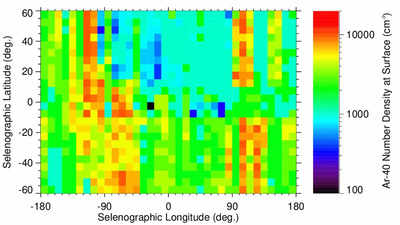- News
- India News
- Chandrayaan-2 makes first observation of global distribution of Argon-40 in lunar exosphere
Trending
This story is from March 8, 2022
Chandrayaan-2 makes first observation of global distribution of Argon-40 in lunar exosphere

The map of relative number densities of Ar-40 at Moon's surface, where the X-axis represents the selenographic longitude and the Y-axis represents the selenographic latitude. Certain regions with enhanced Ar-40 signal are clearly seen.
BENGALURU: Isro on Tuesday said that the mass spectrometer onboard the Chandrayaan-2 orbiter, Chandra’s Atmospheric Composition Explorer-2 (CHACE-2), has made the first-of-its-kind observations of the global distribution of Argon-40 (a noble gas) in the lunar exosphere.
“These observations provide insight on dynamics of the lunar exospheric species, as well as on the radiogenic activities in the first few tens of metres below the lunar surface,” Isro said.
Pointing out that noble gases serve as important tracers to understand the processes of surface-exosphere interaction, Isro said Argon-40 (Ar-40) is such an important tracer atom to study the dynamics of the lunar exospheric species.
“Ar-40 originates from the radioactive disintegration of Potassium-40 (K-40) present below the lunar surface. Once formed, it diffuses through the inter-granular space and makes its way up to the lunar exosphere through seepages and faults,” Isro added.
“As there is a steep latitudinal temperature gradient of the lunar surface, it was, so far, a gap area to study the global dynamics of the lunar exospheric species, which is a temperature-driven process. In this context, the observations by CHACE-2 on Ar-40 up to the mid-latitude regions (−60º to +60º) play a significant role to bridge the gap in the knowledge,” Isro said.
The CHACE-2 observations reveal an increase in the number density of Ar-40 near the sunrise terminator, a decrease through the dayside, a secondary peak near sunset terminator and a night-side minima — a typical behaviour of a condensable gas.
“...The CHACE-2 observations provide the diurnal and spatial variation of Ar-40 covering the equatorial and mid latitude regions of Moon,” Isro added.
Also, for the mid-latitude regions, CHACE-2 observations showed for the first time that the variation in the number density of Ar-40 with respect to solar longitudes are similar to that of low latitude regions, despite the differences in temperature and topography.
“The CHACE-2 observations reveal that the Ar-40 distribution has significant spatial heterogeneity. There are localised enhancements (termed as Argon bulge) over several regions including the KREEP (potassium (K), rare-earth elements, and phosphorus (P)) and South Pole Aitken terrain,” Isro said.
The observations of Argon bulge are indicative of unknown or additional loss processes, Moonquakes or regions with lower activation energies, which call for a better understanding of the surface-exosphere interactions and source distributions of Ar-40, Isro added.
The CHACE-2 was a sequel to the CHACE experiment on the Moon Impact Probe (MIP) of Chandrayaan-1 mission and also draws heritage from the Mars Exospheric Neutral Composition Analyser (MENCA) experiment aboard the Mars Orbiter Mission (MOM).
“These observations provide insight on dynamics of the lunar exospheric species, as well as on the radiogenic activities in the first few tens of metres below the lunar surface,” Isro said.
Pointing out that noble gases serve as important tracers to understand the processes of surface-exosphere interaction, Isro said Argon-40 (Ar-40) is such an important tracer atom to study the dynamics of the lunar exospheric species.
“Ar-40 originates from the radioactive disintegration of Potassium-40 (K-40) present below the lunar surface. Once formed, it diffuses through the inter-granular space and makes its way up to the lunar exosphere through seepages and faults,” Isro added.
The uniqueness of this result from Chandrayaan-2 lies in the fact that although Apollo-17 and LADEE missions have detected the presence of Ar-40 in the lunar exosphere, the measurements were confined to the near-equatorial region of Moon, Isro said, adding that the new findings have been published in the the journal ‘Geophysical Research Letters’.
“As there is a steep latitudinal temperature gradient of the lunar surface, it was, so far, a gap area to study the global dynamics of the lunar exospheric species, which is a temperature-driven process. In this context, the observations by CHACE-2 on Ar-40 up to the mid-latitude regions (−60º to +60º) play a significant role to bridge the gap in the knowledge,” Isro said.
The CHACE-2 observations reveal an increase in the number density of Ar-40 near the sunrise terminator, a decrease through the dayside, a secondary peak near sunset terminator and a night-side minima — a typical behaviour of a condensable gas.
“...The CHACE-2 observations provide the diurnal and spatial variation of Ar-40 covering the equatorial and mid latitude regions of Moon,” Isro added.
Also, for the mid-latitude regions, CHACE-2 observations showed for the first time that the variation in the number density of Ar-40 with respect to solar longitudes are similar to that of low latitude regions, despite the differences in temperature and topography.
“The CHACE-2 observations reveal that the Ar-40 distribution has significant spatial heterogeneity. There are localised enhancements (termed as Argon bulge) over several regions including the KREEP (potassium (K), rare-earth elements, and phosphorus (P)) and South Pole Aitken terrain,” Isro said.
The observations of Argon bulge are indicative of unknown or additional loss processes, Moonquakes or regions with lower activation energies, which call for a better understanding of the surface-exosphere interactions and source distributions of Ar-40, Isro added.
The CHACE-2 was a sequel to the CHACE experiment on the Moon Impact Probe (MIP) of Chandrayaan-1 mission and also draws heritage from the Mars Exospheric Neutral Composition Analyser (MENCA) experiment aboard the Mars Orbiter Mission (MOM).
End of Article
FOLLOW US ON SOCIAL MEDIA











